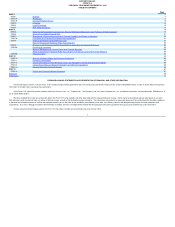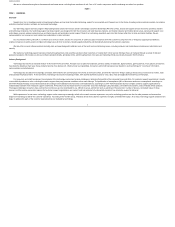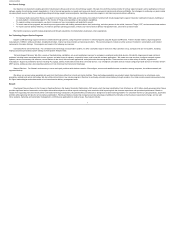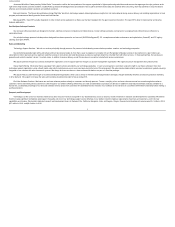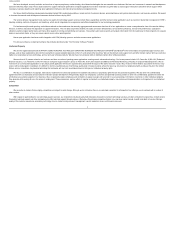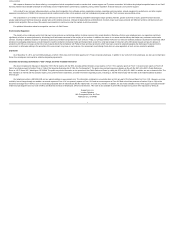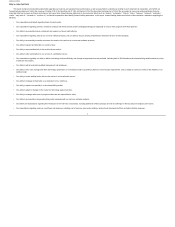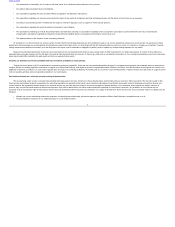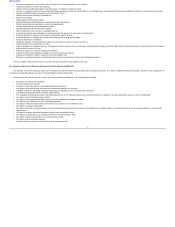Support.com 2014 Annual Report Download - page 13
Download and view the complete annual report
Please find page 13 of the 2014 Support.com annual report below. You can navigate through the pages in the report by either clicking on the pages listed below, or by using the keyword search tool below to find specific information within the annual report.
Table of Contents
Our failure to establish and expand successful partnerships to sell our services and products would harm our operating results.
Our current business model requires us to establish and maintain relationships with partners who market and sell our services and products. Failure to establish or maintain such relationships could materially
and adversely affect the success of our business. We sell to numerous customers through each of these partners, and therefore a delay in the launch or rollout of our services or the reduction or discontinuance of a
program with even one of these partners could cause us to miss revenue or other financial targets. The process of establishing a relationship with a partner can be complex and time consuming, and we must pass
multiple levels of review in order to be selected. If we are unable to establish a sufficient number of new partners on a timely basis our sales will suffer.
Our Nexus SaaS offering is in its early stages and failure to market, sell and develop the offering effectively and competitively could result in a lack of growth.
A number of competitive offerings exist in the market, providing various feature sets that may overlap with our Nexus SaaS offering today or in the future. Some competitors in this market far exceed our
spending on sales and marketing activities and benefit from greater existing brand awareness, channel relationships and existing customer relationships. We may not be able to reach the market effectively and
adequately or convey our differentiation as needed to grow our customer base. To reach our target market effectively, we may be required to continue to invest substantial resources in sales and marketing and
research and development activities, which could have a material adverse effect on our financial results. In addition, if we fail to develop and maintain competitive features, deliver high-quality products and satisfy
existing customers, our Nexus offering could fail to grow. Growth in Nexus license revenue also depends on scaling our multi-tenant technology flexibly and cost-effectively to meet changing customer demand.
Disruptions in infrastructure operations as described below could impair our ability to deliver Nexus to customers, thereby affecting our reputation with existing and prospective customers and possibly resulting in
monetary penalties or financial losses.
Our end-user software revenues are dependent on online traffic patterns and the availability and cost of online advertising in certain key placements.
Some of our consumer end-user software revenue stream is obtained through advertising placements in certain key online media placements. From time to time a trend or a change in a key advertising
placement will impact us, decreasing traffic or significantly increasing the cost or effectiveness of online advertising and therefore compromising our ability to purchase a desired volume and placement of
advertisements at profitable rates. If such a change were to continue to occur, as it did in 2013 and on several occasions in the past, we may be unable to attract desired amounts of traffic, our costs for advertising
may further increase beyond our forecasts and our software revenues may further decrease. As a result, our operating results would be negatively impacted.
Our business depends on our ability to attract and retain talented employees.
Our business is based on successfully attracting and retaining talented employees. The market for highly skilled workers and leaders in our industry is extremely competitive. If we are not successful in our
recruiting efforts, or if we are unable to retain key employees and executive management, our ability to develop and deliver successful products and services may be adversely affected. Effective succession planning
is also important to our long-term success. Failure to ensure effective transfer of knowledge and smooth transitions involving key employees and executive management could hinder our strategic planning and
execution.
If we fail to attract, train and manage our technology specialists in a manner that meets forecast requirements and provides an adequate level of support for our customers, our reputation and financial
performance could be harmed.
Our business depends in part on our ability to attract, manage and retain our technology specialists and other support personnel. If we are unable to attract, train and manage in a cost-effective manner
adequate numbers of competent technology specialists and other support personnel to be available as service volumes vary, particularly as we seek to expand the breadth and flexibility of our staffing model, our
service levels could decline, which could harm our reputation, result in financial losses under contract terms, cause us to lose customers and partners, and otherwise adversely affect our financial performance. Our
ability to meet our need for support personnel while controlling our labor costs is subject to numerous external factors, including the availability of a sufficient number of qualified persons in the workforce,
unemployment levels, prevailing wage rates, changing demographics, health and other insurance costs and the cost of compliance with labor and wage laws and regulations. In the case of programs with time-based
pricing models, the impact of failing to attract, train and manage such personnel could directly and adversely affect our revenue and profitability. Although our service delivery and communications infrastructure
enables us to monitor and manage technology specialists remotely, because they are typically home-based and geographically dispersed we could experience difficulties meeting services levels and effectively
managing the costs, performance and compliance of these technology specialists and other support personnel. Any problems we encounter in effectively attracting, managing and retaining our technology specialists
and other support personnel could seriously jeopardize our service delivery operations and our financial results.
12
EDGAR Stream is a copyright of Issuer Direct Corporation, all rights reserved.


